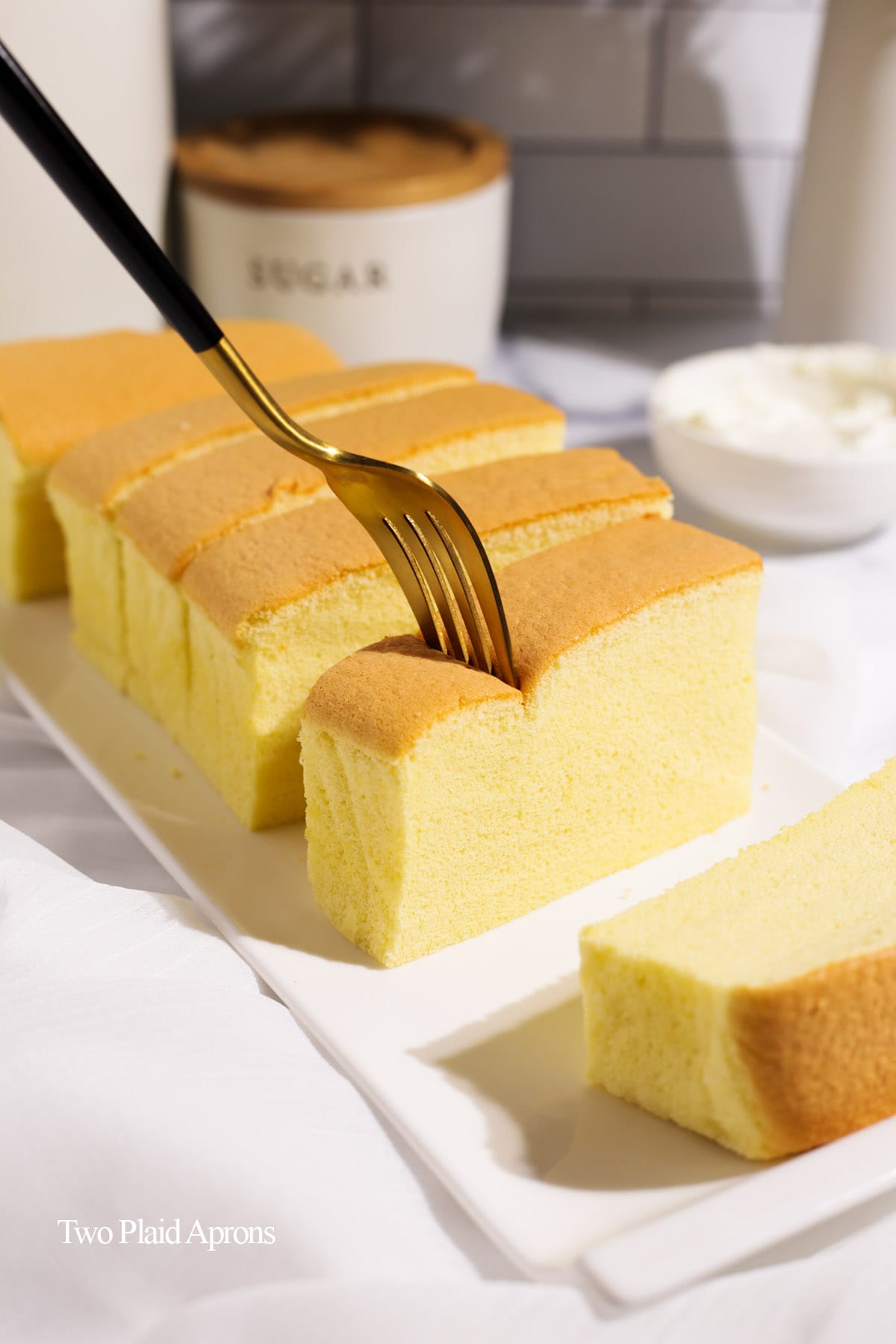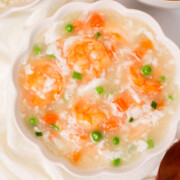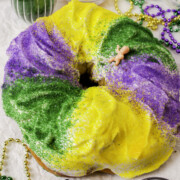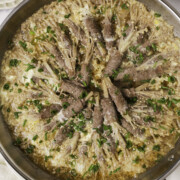Taiwanese castella cake, also known as Taiwanese soufflé castella, is a popular sponge cake known for its soft, fluffy texture and iconic jiggle. It's lightly sweetened and perfect by itself or with some whipped cream and fruits!

In Taiwan, there are so many bakeries and street side venders that specialize in Taiwanese castella cake. It's mesmerizing to watch a huge pan or jiggly sponge cake getting flipped out and cut into rectangles!
Some vendors would even fill the cakes with whipped cream or make savory ones with cheese. They all look so good!
Now after several testings, we're so excited to share this super jiggly and pillow soft castella cake recipe with you!
If you love these Asian street foods like we do, you may also like our Taiwanese fried chicken, Korean cream cheese garlic bread, and hottoek (Korean sweet pancake).
What is Taiwanese castella cake?
Taiwanese castella cake or Taiwanese soufflé castella is essentially a sponge cake baked in a water bath. It's has a caramelized surface and is super fluffy, soft, and makes that beautiful "sha-la-la" sound when you cut or tear a piece of it.
It was popularized in Taiwan from bakeries to street food cafes. And you'd often see Taiwanese castella cake baked in a meter long pan and sliced into large rectangles at those bakeries and cafes.

Taiwanese castella cake vs. Japanese castella cake
Taiwanese castella cake is an adaptation of Japanese castella cake, which was originally introduced to Japan by a Portuguese merchant. The name "castella" came from Pão de Castela, which translates to "bread from Castile."
This castella is made of bread flour, eggs, honey, and sugar, which made Japanese castella denser cake.
The Taiwanese adaptation is made of eggs, milk, oil, sugar, and low gluten flour (cake flour). This gives Taiwanese castella it's iconic jiggly, bouncy and fluffy texture.
Ingredients
- Eggs - This recipe is based on large eggs. If you're using different size eggs, adjust accordingly. The egg whites are whipped into a meringue, and the yolks adds richness to the cake.
- Cake flour - Although all-purpose flour could be used, cake flour is a better choice because it has less gluten. It produces a fluffier, soft cake.
- Oil - Any neutral oil will do. This adds a bit of richness and fat to the cake, keeping the cake extra moist.
- Unsalted butter - Usually, Taiwanese castella is made with only oil because it's lighter and keeps the cake super moist. But we wanted to add some extra flavor to the cake, so we are using some melted butter as well.
- Milk - We used whole milk to thin out the batter. Plus milk adds some extra flavor to the cake. You can also use 2 percent and other low fat milk as well.
- Granulated sugar - This will be the sweetener for the cake, but it'll also help strengthen the meringue.
- White vinegar - You can use white vinegar, cream of tartar, or lemon juice. A little acid helps to stabilize meringues. If you're using cream of tartar, use about ⅛ teaspoon per egg white. For lemon juice, use the same amount or increase to 1 tablespoon.
- Vanilla extract - This is totally an optional flavoring but highly recommended.

How to make Taiwanese castella cake
Preheat and prepare the equipments:
1. Preheat the oven to 300°F and prepare an 8 by 8 by 3 inch square pan lined with parchment paper. Also prepare some hot water and a pan or tray that's larger than the square pan for the water bath. *You can have the water bath already in the oven if you wish.*
Water bath: A container of hot water for a smaller container to be placed in for baking or cooking. This is so that the food/cake can be gently cooked/baked.
🌟 Pro tip: Use a square sheet of parchment that protrudes above the baking pan by ½ inch. This will later help you remove the castella cake easier.
Make the base batter:
2. In a large mixing bowl, sift in the cake flour to remove any clumps. Add the oil and melted butter and whisk until thoroughly combined and smooth.
3. Add the milk and mix until smooth. Then add the egg yolks and vanilla. Mix until well combined. Set aside.

Make the meringue:
4. In another bowl, add the egg whites and vinegar. Using a hand mixer, beat on medium high speed until the egg whites are foam, about a minute a two.
5. Once the whites are foamy, add the sugar in small increments until all the sugar has been added. Decrease the speed to medium and continue to beat the egg whites until medium peak.
🌟 Pro tip: You'll know it's medium peak when you lift the mixer and the meringue forms a peak with a little hook.
6. Add a third of the meringue into the base batter and gently fold with a rubber spatula using a "J" motion to incorporate. Repeat two more times, with a third of the meringue at a time. Make sure to scrape the bottom and sides of the bowl in between each addition.
🌟 Pro tip: You can also use a whisk to fold the first addition of meringue. It's actually a little easier. However, do be gentle or you'll risk deflating the meringue too much!

Bake the cake:
7. Pour the cake batter into the prepared square cake pan and gently shake it to level it out. Then firmly tap the pan on the counter to help pop any large bubbles.
8. Place the cake pan in the prepared water bath and bake the cake for 65 to 75 minutes, or until the cake is golden brown on top and a toothpick inserted comes out clean.
🌟 Pro tip: If the top of the cake is not as dark as you'd like, set the oven to the high broil setting. Let the cake broil until the desired color has been achieved and remove promptly. The cake can go from golden to burnt in seconds, so keep an eye out!
9. Remove the cake from the oven and let it cool for a moment. Then remove the cake from the pan by lifting the parchment. Carefully peel the parchment and cut the cake into your desired size.
10. Hot Taiwanese castella cake will be very jiggly but quite eggy as well. If you don't mind a bit of deflation, let the cake cool completely for best flavor. You can even chill it before serving.
Recipe Tips
- Keep all the ingredients room temperature or warm. Because butter is used, it is best to keep the other ingredients at room temperature or warmer to prevent the butter from solidifying.
- Use a tall square pan if possible. A square pan with tall sides help support the castella cake as it bakes. If you don't have a 3 inch deep square pan, using a reusable parchment can also help support the castella cake.
- If the top of the Taiwanese castella cake is not as dark as you'd like broil the cake. Set the oven to the high broil setting and brown the top of the cake to your desired color. But make sure to keep an eye out! The cake can go from golden to burnt in seconds!

Common Taiwanese castella troubleshoot
Cracks on top of the cake:
- The meringue was too stiff. Whip the meringue to medium peak. Any firmer, the cake will more than likely crack.
- Oven temperature was too high. Because every oven is different, it is best if an oven thermometer is used to determine the true temperature of your oven.
- Baking pan was too small. If your pan is too small, the can will expand outwards as it break and split apart.
Cake deflated:
Although Taiwanese castella cake will inevitably shrink a little when it cools, it should never deflate drastically.
- Meringue too soft. Soft peak meringue produces extra jiggly Taiwanese castella cake, but also promotes more obvious shrinking and deflation.
- Cake was not baked enough. If the cake is baked through, it will sink, deflate, and shrink as it cools. To check if the cake is done, insert a toothpick into the center of the cake. It should come out clean or with very few crumbs.

Cake has inconsistent crumbs/big bubbles:
This issue is mostly aesthetics. The castella cake will taste just as good.
- Meringue was beat at too high speed. Beat the meringue on medium speed after the sugar has been added. This aerates the meringue without introducing large bubbles, which makes the final batter smoother.
- Improper meringue incorporation. When folding the meringue into the batter, use a gently "J" folding motion. If you fold the batter roughly, unnecessary air can be incorporated, producing a coarse, inconsistent crumb.
Storage
After the Taiwanese castella cake has completely cooled, you can individually wrap each piece in plastic wrap or store them separately in air tight containers. They will stay good in the fridge up to 7 days, or in the freezer up to 2 months.
Enjoy chilled or at room temperature. If frozen, let the cake defrost overnight in the fridge or at room temperature until thawed. Surprisingly, the castella cake also tastes good frozen. Try it out!

FAQ
Cracks on the surface of your Taiwanese castella cake can be caused by over whipped meringue, too high oven temperature, or baking in too small of a pan.
Taiwanese castella cake, like all soufflé type cakes, will shrink/ deflate slightly after removing from the oven. To prevent the castella cake from deflating significantly, make sure the meringue is whipped to medium peak and that the cake is baked through.
If you see a dense layer at the bottom of your Taiwanese castella, most likely it's due to the meringue being under whipped. Make sure to whip the meringue to medium peak.
If you’ve made this recipe or any recipes from our blog, please tag us on Instagram using #twoplaidaprons! You can also tag us in your Instagram stories using @two_plaid_aprons. We would love to see your creations! It absolutely makes our day! 🥰
📖 Recipe
Taiwanese Castella Cake
Ingredients
- 10 large eggs room temperature and separated (each egg is about 60-65 grams with the shells)
- 125 grams cake flour (we used Swan's Down brand)
- 70 grams unsalted butter melted
- 70 milliliters oil any neutral oil will do
- 118 milliliters milk room temperature
- 15 milliliters vanilla extract
- 125 grams granulated sugar
- 10 milliliters white vinegar (cream of tartar or lemon juice works too)
Instructions
- Preheat and prepare:Preheat the oven to 300°F and line an 8 by 8 by 3 inch pan with parchment paper. Also prepare some hot water and a larger oven safe tray/pan for the water bath.
- Make the base batter:In a large mixing bowl, sift in the cake flour to remove any lumps. Add the oil and melted butter and whisk until smooth. Add the milk and mix until just combined and the batter looks smooth. Add the egg yolks and vanilla and mix until well combined. Set aside.
- Make the meringue:Place the egg whites with the vinegar in another large mixing bowl. Using a hand mixer, beat the egg whites on medium high speed until foamy. Add the sugar in increments while continuing to mix on medium high speed until all the sugar has been added.
- Reduce the speed to medium and continue to beat the meringue until medium peak. You'll know it's medium peak when you lift the mixer and the meringue forms a peak with a slight hook. *Please refer to the post for photo reference!*
- Incorporate the meringue:Place a third of the meringue into the prepared batter base. Gently fold with a spatula with a "J" motion to incorporate the meringue. Repeat two more times with the remaining meringue. On the last mix, make sure to fold until the meringue is completely incorporated and the batter is uniform in color. Make sure to also scrape the bottom and sides of the bowl!
- Bake the Taiwanese castella cake:Pour the batter into the prepared cake pan and gently shake to level it out. Give the pan a firm tap on the counter to pop any large air bubbles.
- Place the square cake pan in the larger pan or tray and place it in the oven. Pour hot water into the outer pan, about a quarter to half way up the sides of the square pan.
- Bake the castella cake for about 70 minutes, or until the cake is golden brown on top and a toothpick inserted in the middle comes out clean. Remove the cake from the oven.*If the surface of the cake is not as golden brown as you'd like, broil for about 30 seconds.*
- Cut and serve:Let the the Tawainese castella cake cool for a moment then remove it from the cake pan by lifting. Peel the parchment paper from the cake and slice the cake into 8 equal pieces, or to your preferred size.
- The cake is jiggliest while it's hot, but it will taste quite eggy. As it cools, the cake will deflate slightly, becoming less jiggly. Once it's comepletely cooled or chilled, the cake will taste much better. It's great on its own or with some whipped cream and fruits.
Notes
- Whipping the meringue to medium peak is very important. Too soft, the castella cake will shrink a lot after baking, but it will be extra jiggly. Too stiff, the cake will more than likely crack on top. Please refer to the post for a photo reference of what medium peak looks like.
- Folding the meringue - It is important that the meringue is gently incorporated into the batter. The safest way is using a rubber spatula using a "J" motion. Sometimes, I use a whisk to incorporate the meringue, especially the initial addition because it incorporates the meringue more evenly. Albeit, it is unorthodox and a bit riskier.
- If the cake is done baking but the surface color is not as golden brown as you'd like, set the oven to the high broil setting. Broil the cake until golden brown or to your preference. Make sure to keep and eye out! The cake can go from golden to burnt in seconds!






















G med says
Measuring in grams is ok but measurements in millimeter of liquid is hard for most USA kitchens
Mei says
Hi there!
We offer both metric and US customary measurements in the recipe card. Right above the ingredient amount you'll see the two measurement options. Just click on the button to toggle between the two. 😊
Mei❤️
Sue says
This recipe has become my family’s favorite! I bake half a batch in a cupcake pan, and I get about 8 individual cupcake size castellas. Perfect for breakfast on the go, just heat in microwave for 15 seconds the next day and it tastes like a freshly baked castella 🙂
Mei says
Hi Sue!
Thank you for leaving us such a sweet comment! We're so happy that you guys enjoy the castella cakes! They're also a favorite of ours, and I used to make them for my parents occasionally. They'd freeze it for snacks and breakfast as well =)
Mei❤️
Tin says
I have all the ingredients except the cake flour. Will the all-purpose one work? And how much of it? Really wanted to try this
Mei says
Hi Tin!
Cake flour will give you the most tender castella cake with even crumbs. However, you could use all-purpose flour if you prefer. I do not have a specific measurement for A/P flour, but I recommend 120g or 1 cup fluffed, spooned, and leveled. Using a scale will give you the best accuracy of course =) Hope this helps!
Mei ❤️
Lauren says
Perfect! I was inspired to make this after trying it at a bakery and loving it. The recipe is easy, and my mom and I agree it came out even better than the one from the bakery. Thank you for sharing.
Mei says
Hi Lauren! Thank you so much for trying our recipe! So happy to hear that you both enjoyed the cake =)
Mei ❤️
Anna says
Hi! I've fallen in love with castella cakes, thanks a lot for such a detailed recipe and useful tips. Can there be any other issues caisung significant deflation while cooling down? I mean, apart from underbaking or a weak and unstable merengue? I once baked it for 2 hours, but it still deflated very much. I beat my merengue to something between soft and medium peaks, as with medium peaks it cracks 😢 I would highly appreciate your comments
Mei says
Hi Anna! In our experience, our castella cake usually would deflate by about 1/5 to 1/4 from its original size and that's totally normal. Other than underbaking and having an unstable meringue, over folding is often another common issue. Sometimes if the base batter (the portion with the egg yolks and flour) is too thick, it could make the batter too heavy for the meringue. Lastly, if you don't have an oven thermometer yet, I highly recommend it. The oven temperature may not be at where it should be, which could cause underbaking. Hope this helps and good luck!
Mei ❤️
Anna says
Many thanks for your answer! Will try baking again. I have aa thermometer, but it seems to me that it has gone crazy, as it never shows more than 140C with a waterbath inside the oven, even if the temperature controller is set to 170 or 180C. Or maybe my oven is too old and doesn't give enough heat with a waterbath inside. Without waterbath it works well though... Will try to adjust thing and be back with my results))
Mei says
Our pleasure! Hopefully, 2nd time is the charm! But that is odd. We've never had that issue with the oven not maintaining heat after putting in a water bath. I'll have to pay more attention to it next time. In the meantime, you can try heating the oven up to temperature first then put the hot water bath into the oven. As long the oven door isn't left open for too long, the temperature shouldn't drop much. Good luck!
Mei ❤️
Anna says
Dear Mei, I did it! I worked on my meringue and checked my oven thermometer. When I adjusted it all, I made a great castella that didn't deflate and was delicious. Thank you so much for your support!
Mei says
Hi Anna! I'm so happy to hear that your castella cake turned out well and that we were able to help =) Thank you for giving our recipe another try!
Mei ❤️
Alice says
Can I use plant milk for this?
And my cake is a bit dense at the bottom - realised that I used cold water for the water bath, that's probably why? Also wasn't sure whether my meringue was beaten enough - it was dropping onto itself.
Mei says
Hi Alice! You should be able to use your preferred milk alternatives without affecting the texture. Yes, for water bath, please make sure it's hot water. As for the meringue, it should be at medium peak where the forms a peak but hooks down, but the meringue shouldn't flatten onto itself. You can check out the photo we shared in the post above for reference. Hope this helps!
Mei ❤️
Paulyn says
I am a novice baker mom. Tried ur recipe but replaced with gluten free flour & halved the sugar am prepared for failure surprisingly It turned out really well thank you for the wonderful recipe
Mei says
Thank you for trying our recipe, Paulyn! We are really glad you gave it a try and that the castella cake turned out well even with gluten free flour =)
Mei ❤️